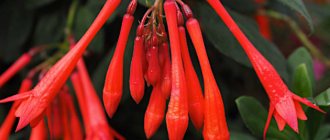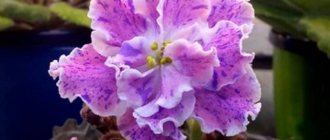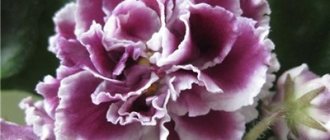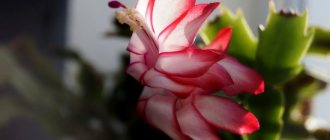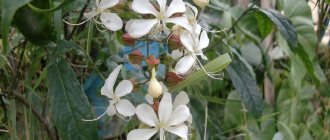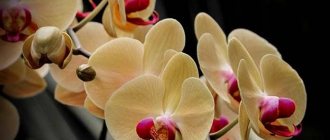Yellow violet description and characteristics
The yellow violet belongs to the Saintpaulia group - this is the name given to violets of African origin, often also called Usambara violets. The reason for this is the distribution area of these spectacular plants in the Usambara region, a mountain range located in eastern Africa. Their discoverer is considered to be the German colonial official Walter von Saint-Paul, from whose name the name of the group of Saintpaulia violets comes. The wild yellow violets he discovered became the ancestors of a number of new varieties of hybrid Saintpaulias.
Yellow violet is an evergreen perennial that takes root well in indoor conditions and is therefore suitable for growing even in northern regions. The stems of Saintpaulias are usually short, and the heart-shaped leaf blades have a short edge along the entire surface. The calyx consists of 5 sepals and the same number of petals. The average diameter of a yellow violet rosette ranges from 20 to 40 cm. However, varieties with a diameter of about 60 cm are known, as well as very miniature varieties of about 6 cm. During the fruiting period, the seed pods ripen.
Strictly speaking, wild yellow violets do not have a yellow color, since this color variant is absent at the genetic level. Most often, the petals of these flowers are colored in blue, blue and dark red tones, and yellowness is present in the form of small inclusions of various shapes. It is the presence of spots, specks or streaks of yellow that allows such violets to be called yellow. As for hybrid Saintpaulias, the intensity of their color increases as they grow older: if the petals of a young plant have a light lemon or creamy tint, then with age they become bright yellow.
Distinctive features of the species
One of the features of yellow violets is the weak growth of the root system in depth. In this regard, the roots of Saintpaulia are forced to constantly renew themselves in order to properly perform their function. For this reason, growing yellow violets in large containers does not make sense - it is enough to plant them in small pots that will accommodate their compact root system. In this case, the flower will receive enough oxygen, especially if you take care of the presence of holes at the bottom of the pot, as well as the drainage layer.
Today, a large number of varieties of yellow violets have been developed, which differ from each other not only in color, but also in the shape of the petals. They can be simple, corrugated, star-shaped. The petals of some varieties have a border.
Yellow violets can be divided into two large groups based on gender. Thus, male plants are distinguished by a uniform color of foliage, while female plants have a light-colored spot on the outer side of the leaf blade.
Varieties
- “Ripe Yellow” (MellowYellow) is a variety of yellow violets, distinguished by the unusual shape of its petals. Their wavy surface creates the effect of a compact fluffy ball, painted in a delicate light yellow shade. The first wave of flowering produces the largest flowers up to 3 cm in diameter, the sizes of subsequent waves are more modest - no more than 2 cm in diameter. In young plants the petals are almost white; with age, the color intensity intensifies. The jagged, light green leaves have uneven contours. The spectacular appearance of violets of the “Ripe Yellow” variety is combined with quite significant drawbacks. These include rapid fading of flowers, as well as not too lush flowering in general. Plants of this variety often get sick.
- “Warm Sunshine” – yellow violets of this variety are distinguished by long-lasting flowering, which is ensured by continuously ripening buds. The compact flowers have a lush shape and are similar in appearance to lotus flowers. Only the opened cups are white in color - yellow spots are barely noticeable on the petals, while the core has a pronounced yellow color. The flowers of the first wave do not acquire the characteristic light yellow hue - the yellowness intensifies with repeated flowering. The process of opening flowers is quite long - while it lasts, the petals remain fresh. A fully opened flower quickly turns brown and withers.
- “Golden Autumn” - an unusual combination of white and yellow flowers is typical for violets of this variety. The lush flowers are predominantly white in color, against which a golden-hued border and a yellow central part of the calyx stand out. Light yellow spots are also present on the petals with wavy contours. The same unusual edges are characteristic of light green leaf blades. The interval between long waves of “Golden Autumn” flowering ranges from 2 to 4 months.
- “Lemon Kisses” is a double variety of yellow violets. The large flowers of the first wave of flowering are painted white, their core seems to flicker with yellow hues. After several blooms, the petals become yellow. The disadvantages of the variety include the transience of flowering; for this reason, the mass flowering of “Lemon Kisses” is very short-lived. As a rule, by the time some flowers bloom, others have already withered.
- “EK-Sunny Girl” is a Russian hybrid variety of yellow violet. The large flowers consist of wavy petals with an unusual pink and white color and a bright yellow core. The leaf rosette is formed of bright green wavy leaves that taper at the base.
- “RS-Golden Dragon” is a variety distinguished by impressively sized flowers, painted white with an admixture of yellow tones. The yellow lines coming from the core gradually become yellow spots covering the entire surface of the petals. The yellowness becomes more noticeable during reblooming. The diameter of the flowers of the first wave is about 9 cm; subsequent waves do not differ in this size. The wavy leaves are a dull green color. The “Golden Dragon” is characterized by the formation of a large number of stepchildren, as well as the slow growth of children. Lack of lighting causes vertical arrangement of leaves in the rosette. Unlike most yellow violets, the flowers of this variety do not turn brown as they wither.
- “AV-Yellow Rose” is a variety of yellow violets that is stunning in its decorative qualities. The rose-like small double flowers are white with a clear yellow tint and have a pink border around the edges of the petals. The green leaf blades have jagged contours.
- Alchemy Yellow Bells are a variety of miniature yellow Saintpaulias. As the name suggests, the flowers are characteristically bell-shaped. The petals have wavy edges and are colored a mixture of yellow and pink shades. At the time of flowering, a large number of buds bloom, however, they quickly fade, so the flowering is not lush. The average wave duration is 14 days. After two waves, the shoots of the plant begin to lengthen, and the leaves and petals lose their color saturation. Blue stripes may appear on the latter.
- "Yellow Star" is another representative of miniature Saintpaulias. The bell flowers are pale yellow with splashes of lilac. The yellow becomes brighter as the plant matures. The first wave, as a rule, is the least spectacular - the flowers are small. In subsequent waves they become larger and more beautiful. The shape of the flowers is also star-shaped. The shape of the leaf plates is heart-shaped.
Varieties and types
In the process of breeding work, various varieties were developed, here are some of them.
- Mellow Yellow. It is considered one of the best representatives of Saintpaulias with yellow flowers. The flowers have a wavy structure along the edges, the color is bright yellow, double flowers in the shape of stars.
- Lemon kiss. This variety has fairly large double flowers of a lemon shade. There is a pink border visible around the edges. The plant looks very delicate, the rosette is compact, and the bouquet is lush.
- Sukissed Rose. This variety has double flowers, shaped like a star, light yellow in color with a yellow center. Shades of pink are visible along the edges of the petals.
In general, caring for Saintpaulias at home is not very different from other representatives of Saintpaulias. But it is worth remembering that yellow-flowered violets are more delicate, and when growing them, you need to take into account the characteristics of these plants. If you follow all the recommendations, yellow-flowered violets will open in all their glory during flowering.
Yellow violet growing
A competent choice of the place in the apartment where the pot of violets will be placed is the key to its successful cultivation. Yellow violets feel best on window sills facing west or east. To ensure that the plant is illuminated evenly, it is recommended to rotate it periodically. In the dark season, the deficit of natural sunlight can be compensated by sources of artificial lighting - this will help prolong the flowering of Saintpaulia.
Sudden temperature changes are dangerous for yellow violets, which prefer to be in a room with a constant room temperature. With the arrival of cold weather, it is better to remove them from the windowsill.
Saintpaulias are very sensitive to watering: water should be at room temperature, watering should be moderate. It is important that the soil in the pot does not dry out, but is also not waterlogged. With the onset of winter, yellow violets need to be watered less frequently and more sparingly. When watering, water should not get on the petals and leaves, so it should be poured along the edge of the pot.
In order to increase the air humidity in the room where the yellow violet is located, it is enough to place the pot with the plant on a tray filled with wet pebbles. It is not recommended to spray Saintpaulia.
Yellow violets require fertilization during the flowering period. Fertilizers are applied once every 14 days while watering the plant. A mineral complex rich in phosphorus is best.
Under indoor growing conditions, propagation of yellow violets is carried out by two methods - cuttings and divisions. The first method is considered the most effective. A strong leaf on a stalk about 3 cm long can act as a cutting - it must be placed in water and left there until roots appear. After this, the cutting can be transplanted into a container with soil, deepening it no more than 2 cm. After planting, the cutting needs to be watered with warm water. Such bushes can be replanted no more than once every 12 months. Soil for propagating violets can be purchased at a specialty store.
Violet. Description, care
Violets are grown by many women who enjoy their long-lasting blooms and variety of color shades. Even an amateur can take care of unpretentious flowers. Violet is a low bush with soft leaves on a short stem.
Bloom
Small flowers of a wide variety of colors are collected in a racemose inflorescence.
Now breeders have developed varieties of violets in all shades of the rainbow. Flowers are bicolor, with a border decorated with dots, bright lines or spots of a different shade. Single and double violets have been bred. There are those in which the outer petals form 3-4 rows.
- It is better to place a pot of violets on a window facing north, east or west. There the plant will not be bothered by the bright rays of the sun, which can burn their leaves, forming dark spots.
- Violets feel great and bloom for a long time at a temperature of 20-24 ° C. With a sharp decrease or increase in temperature, the leaves rot and the flowers fall off.
- To form new leaves and lush flowering, the plant will have to be pinched.
- The outer leaves gradually fade and need to be separated from the cuttings.
- It is necessary to remove yellow leaves and weak inflorescences.
- The violet needs to be constantly rotated so that the bush is evenly illuminated
Watering
The plant is watered in three ways. The plant needs to be watered once a week, when the top layer of the substrate dries out. When it's hot, you should water more often.
- It is best to slowly water from a watering can or syringe along the edge of the container so that the substrate does not wash out. Do not let moisture get on the leaves.
- You can pour water into the pan, and after half an hour drain the excess water. If the water is not removed, the soil will become excessively moist, which will lead to rotting of the roots.
- It is best to lower the pot with the plant in a wide basin of water for a quarter of an hour. The leaves should be above the water. Then the water will definitely not wet the leaves, and the soil will absorb the necessary moisture. But the container must have holes to drain excess moisture.
The soil
In specialized stores you can purchase special soil for Saintpaulias, which is quite suitable for violets. You can prepare the soil yourself. To do this, mix leaf soil with humus and sand and add turf soil in a ratio of 2:1:1:0.5. It is advisable to add 1 tbsp to the mixture. a spoonful of superphosphate and a little ash. Then the soil will become soft, with a slightly acidic reaction. A layer of expanded clay or small pebbles is placed at the bottom of the pot.
Top dressing
Violets are fed several months after planting. When new leaves grow, then after 10 days the Saintpaulias need fertilizing. If you use universal fertilizers, you will have to dilute them twice as weak as the concentration written in the instructions.
Yellow violet: disease prevention
A lack of lighting leads to damage to yellow violets by rust - yellow spots appear on the upper parts of the leaf blades. The appearance of soft brown spots on stems and foliage indicates the development of bacteriosis caused by too hot weather. A white coating on the surface of the leaves signals that the violet is infected with powdery mildew. If whitish spots cover the lower part of the leaves, this is a sign of downy mildew.
At the first symptoms of infection, it is necessary to immediately trim the infected parts of the violet. The remaining shoots, leaves, flowers, as well as the soil in the pot must be treated with a fungicide. As a preventative measure, you can carry out the first treatment ahead of time, even at the time of planting the plant in the pot. A proper balance of fertilizing will prevent the development of diseases.
In general, yellow violets are quite unpretentious and do not require special care. A novice gardener can try his hand at growing a variety of miniature Saintpaulias. As you acquire knowledge and skills, you can move on to growing large hybrids.
Caring for yellow violets at home: basic rules
Among the variety of Saintpaulia flowers, there are flowers in blue, purple, red and white shades, among which yellow violets stand out. But the name does not fully reflect the color of these beautiful flowers. Breeders have been trying to isolate the yellow color of flowers for several decades, but to no avail. Violets do not have the gene that makes their petals yellow, so those violets that are considered yellow actually have pink pigment.
The most that the breeders managed to do was to develop varieties with lemon-colored veins and a yellow center of the calyx. The yellow pigment acquired as a result of mutations easily dissolves in water, which makes growing such violets a very difficult process. In other varieties that have flowers of other shades, the pigments have a carotene base, which is more durable and gives the flowers a rich color.
Yellow Saintpaulia – when should we expect it to appear?
The history of the Uzambara violet began in 1892, when the governor of the German colony in East Africa, Baron Walter von Saint-Paul, discovered this extraordinary plant in Tanzania, in the Uzambara Mountains region. Hence this plant has two names: Usambara violet and Saintpaulia.
In 1920, the Californian firm Armacost & Royston began commercial cultivation of Saintpaulia in Los Angeles. Its founder was Walter Armacost, who conducted a series of experiments on their reproduction.
Sunkissed Rose
In nature, violet has a rather narrow range of colors: blue, blue, purple. Currently, the color palette of Saintpaulias is quite wide; Moreover, there are types of Saintpaulias with different colors in one variety. Despite such successes, breeders have not yet succeeded in breeding bright yellow Saintpaulia, although some successes in this direction are still being observed: varieties of white violets with lemon veins have been bred; with a yellowish tint in the middle of the flowers.
Silverglade_Apples
Many leading genetic engineering specialists have long been trying to develop yellow varieties of Saintpaulia. But the fact is that these violets do not have the gene responsible for the yellow color of flowers.
This yellowness is essentially just a variant of the pink pigment. Pure yellow Saintpaulias do not yet exist.
Moonlit Snow
While for open ground flowers (tulips, carnations, roses, chrysanthemums, etc.), almost all the genes responsible for the production of flower color pigment have been found. Therefore, today, obtaining varietal yellow Uzambara violets still depends on the skill and luck of the breeders.
Majesty
This is confirmed by the appearance of such varieties of “yellow” Saintpaulia as Moonlit Snow, Majesty, Lemon Kisses, Golden Threads, Golden Fountain, Sunkissed Rose, Winter's Sunshine, etc., but it is still difficult to call them yellow violets.
Lemon Kisses
Golden glow
If you notice an error, select the required text and press Ctrl+Enter to report it to the editors
Comments:
There are no comments yet, you can add your own comment. For this you need to register or log in.
